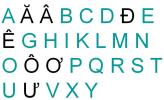 Attending the Polyglot Conference in Thessaloniki, late last month, has inspired me to do a bold and daring thing: start learning Vietnamese. While the language may appear small in comparison to its northern neighbour, Chinese, it actually has no fewer than 80 million speakers. Moreover, one of these, a friendly and wonderfully efficient woman named Tuyết, happens to clean our house every fortnight, so I may have an opportunity for practice there – or at the very least, I will be able to surprise her one of these days. (Days? Make that ‘weeks’. Or ‘months’, more likely.)
Attending the Polyglot Conference in Thessaloniki, late last month, has inspired me to do a bold and daring thing: start learning Vietnamese. While the language may appear small in comparison to its northern neighbour, Chinese, it actually has no fewer than 80 million speakers. Moreover, one of these, a friendly and wonderfully efficient woman named Tuyết, happens to clean our house every fortnight, so I may have an opportunity for practice there – or at the very least, I will be able to surprise her one of these days. (Days? Make that ‘weeks’. Or ‘months’, more likely.)
Another good thing about Vietnamese is that it uses the Latin alphabet, so I won’t have to learn thousands of characters, only the meaning of nine diacritics: the tilde, the acute, the dot below, and so on. Moreover, Vietnam is an attractive tourist destination, so I may one day go on holiday there. (Or perhaps not. I’ve been flying a lot recently, and I should get back to practicing what I preach, climate-wise.) The main downside is that, like Mandarin, Vietnamese has tones, and even more: six instead of four. But hey, I have a good ear for tone in music and I grew up with a pitch language, Limburgish, so that should give me something of a head start.
Still, I haven’t yet mentioned the main reason to embark on this adventure, which is that I’d like to report on it in Babel, the book I’m working at. Babel will be about the world’s twenty largest languages, and Vietnamese is one of them. I’m sure the language has all sorts of surprises up its sleeve, and I’m looking forward to being amazed and amused and frustrated and rewarded – which I hope will make for an interesting chapter in Babel.
Right now, I’m trying to figure out what might be a good way to start cracking this rather exotic nut. There’s an Assimil course on its way to my address (the German version; it also exists in French, but somehow not in English). I already owned a language guide from the German Kauderwelsch series, which tends to be good. And there is of course a lot of free stuff online: the big names, such as Duolingo, Memrise, Forvo, but also dozens of videos featuring a Saigon-based native speaker and teacher named Annie.
Time to take the plunge. I’ll keep you posted.
****
You can find the other blogposts about my adventures in Vietnamese here.

Over d en đ hebben we ook al enkele verwarrende gesprekken gehad! En dan denk je dat je het onder de knie hebt en hoor je plots je vriend die g als d uitspreekt… maar dan troost ik mezelf met de gedachte dat er ergens in Vietnam wel een dorpje zal zijn waar ze alles ‘standaard’ uitspreken en me wel zullen verstaan haha
LikeLike
Over de “g”: deze staat nooit direct vóór de e, maar altijd met een i ertussen, dan spreek je uit als een zachte “d”, als een “dz”, of als een “j” in het Nederland. G staat direct vóór de klinkers a, o, u (met alle varianten hiervan bv â, ư ô… wordt als gh (in het engels, zoals Ghana) uitgesproken.
Nguyễn Hiền
LikeLiked by 1 person
Dat heb ik in deel 2 zo beschreven inderdaad. Maar eigenlijk is dat (Italiaanse) systeem in het Vietnamees helemaal niet nodig! Die hele gh hadden ze kunnen schrappen. Maar ja, spelling is conservatief.
LikeLike
Toevallig op deze blogspot gekomen, maar ik volg mee in de toekomst! Er zijn namelijk zo weinig Belgen die Vietnamees leren… je zult echt nog versteld staan van hoe praktisch de taal wel niet is. Ipv allemaal verschillende woorden voor weekdagen, zeg je dag 1, 2, 3, etc. En idem voor de maanden! De grammatica is vrij logisch en je hoeft je niet al teveel zorgen te maken over de tonen. Mijn vriend is Vietnamees en hij maakt bijvoorbeeld geen onderscheid tussen ả en ã. Of als ik hem vraag grappige zinnen uit te spreken als cho chó chờ chợ (voor de hond die wacht op de markt), dan spreekt hij ze zelf soms zonder tonen uit. Het zal een heel leuk avontuur worden! Veel succes!
LikeLike
Ja, die dagen en maanden, dat was een aangename ontdekking. Nu nog even de cijfers tot twaalf leren ;), maar dat lukt vast.
Wat die tonen betreft: inderdaad, het is tamelijk verbijsterend hoezeer die per dialect variëren. Alleen al voor het woordje dễ kom ik hier 6 verschillende ‘melodietjes’ tegen, en dan wordt de d ook nog op 2 à 3 manieren uitgesproken. Nou ja! En toch verstaan ze elkaar, geloof ik. Nu ik nog…
LikeLike
Yes please do.
LikeLike